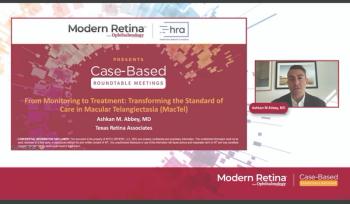
What APL-2 means for geographic atrophy
Treating geographic atrophy (GA) with complement C3 inhibitor pegcetacoplan 15 mg (APL-2; Apellis Pharmaceuticals) resulted in slowed atrophy growth when compared with placebo at 12 months, said Nathan Steinle, MD.
APL-2 is a synthetic cyclic peptide conjugated to a polyethylene glycol (PEG) polymer that binds specifically to C3, "effectively blocking all three pathways of complement activation (classical, lectin, and alternative)," making it the first compound to broadly block the complement cascade upstream, according to Apellis.
"We all know age-related macular degeneration (AMD) is multifactorial with both genetics and environmental risk factors," said Dr. Steinle, of California Retina Consultants. "However, inflammation and the local activation of the complement system might play an important role in the pathogenesis of AMD."
It is likely local inflammation with complement activation contributes to the pathogenesis and progression of AMD.1 Dysfunction of the alternative complement pathway has been linked to the pathogenesis of AMD through numerous genetic studies.
Dr. Steinle presented 18-month results of the phase II FILLY study, a prospective, randomized, sham-controlled, single-masked trial that enrolled patients with GA area measuring 2.5-17.5 mm2 and best-corrected visual acuity (BCVA) of 24 letters or better (20/320 Snellen equivalent). A previous history of exudative AMD and GA in the fellow eye was allowed, as there were no exclusion criteria for the fellow eye.
The FILLY Study
FILLY is the largest phase II trial evaluating dry AMD to date, Dr. Steinle said.
FILLY enrolled 246 subjects from 43 clinical sites across the United States, Australia, and New Zealand. Subjects were randomly assigned (2:2:1:1) to four arms; APL-2 monthly (n = 86), APL-2 every other month (EOM; n = 79), sham monthly (n = 41), and sham EOM (n = 40).
The total treatment period was 12 months followed by a 6-month observation period. The 12-month primary efficacy outcome was the difference in mean change from baseline in square-root GA area based on fundus autofluorescence (FAF).
Secondary endpoints included the change in BCVA and the incidence of conversion to exudative AMD, as well as other safety endpoints. Baseline characteristics were similar across the arms.
Of interest, 85.5% (n = 71) in the APL-2 monthly arm had bilateral GA, as did 82.1% (n = 64) in the APL-2 EOM arm, and 90% (n = 70) in the sham pooled arm.
"The square-root formulation mathematically minimizes the differences in baseline GA lesion sizes," Dr. Steinle said.
Results
At 12 months, using least squares mean change from baseline in square root lesion area, monthly APL-2 (n = 84) slowed GA growth by 29% (p = 0.008) and EOM APL-2 (n = 78) slowed GA growth by 20% (p = 0.067) versus the pooled sham group (n = 80), both of which were statistically significant (the study was powered to detect statistical significance at p = 0.1).
The effect was most prominent in the second six months of treatment, during which monthly and EOM APL-2 slowed GA growth by 47% (p < 0.001) and 33% (p = 0.01), respectively, compared with sham. No differences in BCVA outcomes were observed between groups.
Apellis just released the 18 months results[2] where both monthly APL-2 and APL-2 EOM continued to slow progression of GA lesion growth when compared with sham (p = 0.044 and p = 0.097, respectively).
"What this trial showed us-and what we expected, given the chronic nature of this disease-was that the effect of APL-2 was greatest in the second 6 months of treatment and once treatment was stopped, the atrophy progressed at the same rate as sham," Dr. Steinle said.
Most adverse events were attributable to the intravitreal injection procedure.
"By blocking C3, there is theoretically a higher concern for endophthalmitis, but this was not significantly borne out in the study," Dr. Steinle said.
There was a dose-dependent difference in onset of investigator-determined study eye conversion to exudative AMD at 18 months: there were 18 eyes (20.9%) with exudative AMD in the study eye in the APL-2 group, seven in the APL-2 EOM group (8.9%) and one in the sham pooled group (1.2%).
Those events were more common in subjects with a history of choroidal neovascularization (CNV) in the fellow eye. Those eyes discontinued APL-2 treatment, received standard of care treatment, and overall visual and anatomic outcomes were not negatively impacted, he said.
"This was a single-masked study without reading center confirmation of active CNV formation," he said. "It is fair to note we do not fully understand where this exudation is coming from and that patients responded well to anti-VEGF therapy if needed. We will certainly learn more from the results of the upcoming phase III studies."
Two phase III studies will start later this year with a goal of enrolling 1,200 patients across 200 international sites.
References:
References
1. Anderson DH et al. A role for local inflammation in the formation of drusen in the aging eye. Am J Ophthalmol. 2002;134:411-431.
2. Apellis pharmaceuticals announces 18-month results of phase 2 study (FILLY) of APL-2 in geographic atrophy.
Newsletter
Keep your retina practice on the forefront—subscribe for expert analysis and emerging trends in retinal disease management.












































